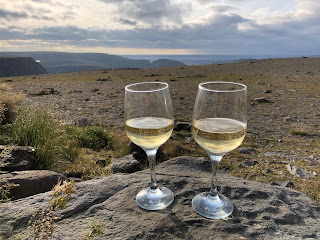Tonight finds us parked close to a cliff, looking across the Barents Sea with the cold wind howling around the van. We have finally reached Nordkapp, the North Cape, a month after crossing the border from Sweden into Norway. That crossing took place in hot sunshine, now the sky is grey, the temperature is some 20 degrees cooler and the landscape has changed to tundra. This is the most northerly point in mainland Europe that can be reached by road.
 |
| Spaniel territory |
 |
| The remains of the copper mine on the hill |
Kafjord was also the place where the German battleship, Tirpitz, was stationed in a bid to tie up British naval forces. In 1943 she was badly damaged following a daring attack by Royal Navy mini submarines. A stone in the graveyard of Kafjord church commemorates the British officers and men who lost their lives in the attack. Tirpitz never sailed again and was later sunk by RAF Lancaster bombers.
Our next stop was Alta where we visited the museum. Its most valuable treasure is outside the building, a large number of rock carvings dating back some four or five thousand years, a UNESCO World Heritage Site. Left where they were originally carved in the arctic climate, many have faded but some of the images of deer, bears, fish and ships have been highlighted in red paint. From there we moved on to the local church where we checked the graveyard but realised it had been built too late to have any connections with Cornish miners. Our attempt to get into the church itself was thwarted by a man at the door shooing us away because there was a wedding in progress. We paid a quick visit to a supermarket and then to the state off-licence for a much-needed box of white wine. Unfortunately it closed at 3pm. How Norwegians ever manage to drink any alcohol is beyond me.
 |
| Rock carvings in Alta |
 |
| The spaniels have left their mark...until it rains |
We found that, like Lands End, Nordkapp is very commercialised and we were prepared for
the 500 kroner cost of getting in and staying for the night. The hit on our wallets was somewhat eased by the cheerful man at the pay point who told us he had studied at Birmingham University and lived in Worcester. With evening approaching we walked around the very high cliffs, took the obligatory photograph close to the globe that marks the Northern edge of the site, and retired from the biting wind for a celebratory glass of champagne and the rest of the reindeer fillet. Tomorrow we will see what the visitor centre has to offer and then plan to turn Florence's nose south towards Finland and the beginning of our journey to a Greek Christmas.






No comments:
Post a Comment
Note: only a member of this blog may post a comment.